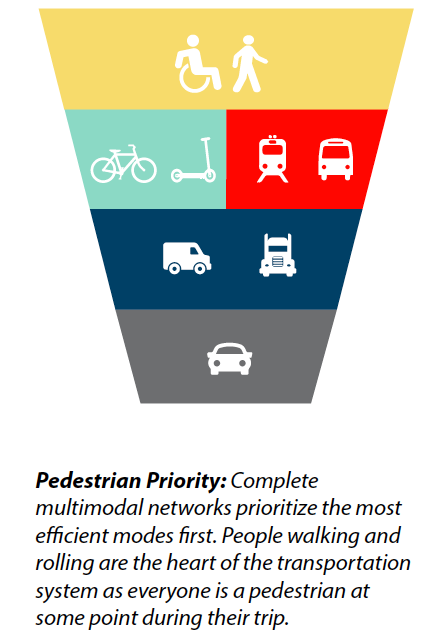Last year, Denver City Council adopted an update to Blueprint Denver, the citywide plan that will guide land use and transportation planning for the next 20 years. Thanks to the advocacy of the Denver Streets Partnership, the plan prioritizes people walking and rolling at the top of our transportation system, followed closely by people biking and using transit. An important step toward realizing the vision and goals embodied in Blueprint is the development of more detailed plans through Denver’s neighborhood planning initiative.

Pedestrian Priority: Complete multimodal networks prioritize the most efficient modes first. People walking and rolling are the heart of the transportation system as everyone is a pedestrian at some point during their trip.
The City recently released the latest draft neighborhood plan for the East Central area. We’ve read closely through the plan, and found a lot to like. Similar to Blueprint, the plan includes measurable goals for reducing dependence on driving and eliminating traffic fatalities in the East Central area, and outlines clear policies for achieving these goals. These policies include making bold changes to the mobility system by repurposing street space along key corridors to prioritize safe and accessible walking, biking, rolling, and transit.
In addition to these mobility elements of the plan, we were also pleased to see recommendations for increased density along Colfax and other priority transit corridors. Allowing density near transit increases the number of people who can access the service and use it on a regular basis, maximizing the benefit of existing and future transit investments. Building affordable housing units near transit further ensures access for people who need it the most, including the 36% of households in the East Central area considered cost-burdened. Density that allows people to live close to their daily destinations also makes walking and biking a realistic option for getting from place to place, rather than forcing people to live so far away that driving is the only practical option for getting where they need to go.
We also identified a few areas where the plan could be made even stronger, including more aggressive mode share goals for transit, walking, and biking; the identification of more north-south bike routes for better connectivity; considerations for micromobility; and more clarity on the prioritization of curb space, with car storage ranked as a lower priority. Read more about our comments on the plan on the here and be sure to submit your own comments directly on the plan document, or through the general comment form.

